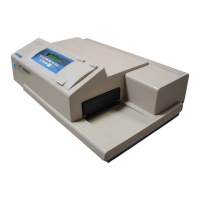SpectraMax M3, M4, M5, and M5
e
Multi-Mode Microplate Readers
0112-0115 F 27
For more information regarding optimizing excitation and emission
wavelengths using the spectral scanning capabilities of the SpectraMax
series readers, see
Optimizing Absorbance Assays on page 44.
Time-resolved Fluorescence (M4, M5, and M5
e
only)
In normal fluorescence mode, the SpectraMax readings are taken while
the lamp is on. The most common limitation to sensitivity in normal
fluorescence is excitation energy or background fluorescence that
cannot be eliminated from the emission signal. Since the lamp is the
source of excitation energy, turning it off provides the best means of
eliminating background excitation. The elimination of background
excitation is the critical difference between fluorescence intensity
measurements and TRF measurements.
Time-resolved fluorescence is performed by flashing the excitation
lamp and, after it is off, collecting the delayed emission for a period of
time before the lamp is flashed again. Long-lifetime rare-earth
lanthanide dyes are typically used to provide a long-lived fluorescent
signal that persists after the lamp is turned off. Background
fluorescence usually fades after 50 µs, while lanthanide chelates and
cryptates have fluorescent lifetimes between 100 µs and 2 ms.
To optimize data collection for a particular assay, the user can select
when to start and end data acquisition-the minimum is 50 µs after the
lamp has been turned off, and the maximum is 1450 µs, in 50- or 200-
µs steps.
Some examples of TRF assays are:
• IMAP
®
TR-FRET
• Cisbio HTRF
• LanthaScreen TR-FRET
• LANCE TR-FRET
• DELFIA TRF

